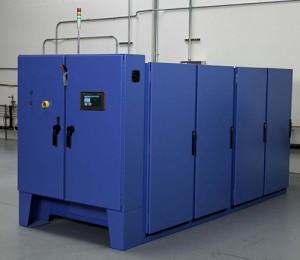Expanding propane’s portfolio with biopropane technology

A prototype of Alkcon Corp.’s MP8K methane-to-propane conversion system in development. The unit is designed to produce 4,200 gallons of propane per week from a qualified biogas source. Photos courtesy of Alkcon Corp.
A race to establish market share is brewing among competing biopropane developers eager to commercialize a technology that is gaining support among global government policymakers and private sector entrepreneurs as an effective method of reducing greenhouse gas emissions and meeting sustainability targets.
“This cutting-edge process has the potential to revolutionize the production of biofuel, forgoing the environmental issues associated with extracting fuel from nonrenewable sources and drastically reducing the transport costs and carbon emissions associated with production,” says Michael Smith, a professor at the University of Manchester (England), who is among the founders of C3 Bio-Technologies, a firm seeking to implement an economically feasible method of full-scale biopropane production.
Created from a variety of feedstocks, “it shares all of the benefits of traditional propane as a fuel, such as substantial reductions of hydrocarbon, carbon monoxide and oxides of nitrogen. However, unlike compressed natural gas – methane – propane is not a greenhouse gas,” says Lauren Scott, founder and CEO of Sparks, Nev.-based Alkcon Corp.
Interest in Europe
The company has inked a deal granting Europe’s Flogas exclusive rights to market Alkcon’s proprietary methane-to-propane gas conversion system in the United Kingdom, Ireland, France, Norway, Sweden, the Netherlands and Belgium. Another overseas propane provider, Kosan Gas, has also shown interest in distributing biopropane in the Nordic countries and Central Europe.
During the second quarter of this year, Flogas plans to begin installing Alkcon’s patent-pending MP32K processing units at biogas production sites across Europe.
In September, Neste Oil broke ground on a $65-million biopropane refinery in the Netherlands, scheduled for completion by the end of 2016. SHV Energy has been selected to market the 40,000 tons of annual output in France, Germany, Scandinavia, Benelux (Belgium, the Netherlands and Luxembourg) and the U.K.
“Biopropane is a wonderful addition to our product portfolio, and our customers can benefit from it,” says Fulco van Lede, SHV management board member.
“LPG already provides our customers with a cleaner rural energy choice to the high-carbon fuel alternatives many are dependent on in off-grid areas. Biopropane means this option will become even cleaner,” he says. “In use, it is identical to conventional propane and can be blended and used by all existing appliances suitable for use with propane. In addition, biopropane is a great opportunity for SHV Energy to lead the LPG business toward a more sustainable future.”
Alkcon has been ahead of Neste all along, Scott counters, and that it’s simply a race to build the machine. She expresses skepticism over the refinery’s cost.
Alkcon’s MP32K unit will be priced at less than $1 million, Scott says. Three other less-expensive models remain under development, designed small enough for installation at sites close to available feedstock materials.
“The overall size of the equipment will lend to it being installed at a wide variety of locations around the world,” Scott says. “However, the economics of scrubbing the methane feed gas (removing impurities) at each site must be considered first.”
Making use of waste
Alkcon’s business model is built around the utilization and monetization of waste resources. Its technology could be used to recover methane and ethane flared from oil and gas production sites, where pipeline access is lacking.
“Our gas conversion process could be used to create value from decomposing organic material in landfills, on farms and in urban areas,” Scott says. “There has been significant interest globally in biogas production from organic waste. Unfortunately, in many areas where tons of waste could be utilized, there is no opportunity to inject biomethane into a high-pressure natural gas system or connect an electrical generation system to the grid.”
Alkcon’s process allows biomethane to be converted to biopropane, which can be transported using bobtails and railcars, Scott explains. In many cases, the logistical paths are short, as propane is regularly consumed in agricultural areas that produce a significant amount of biodegradable waste, she adds.
The primary sources of methane releases are enteric fermentation by livestock, landfill gas, wastewater treatment, petroleum and gas operations, rice cultivation, coal mining and manure decomposition.
“Nearly 50 percent of this methane otherwise released to the atmosphere could be captured and monetized, thus slowing climate change while creating a revenue stream for entrepreneurs in remote areas,” Scott says.
She adds it’s more productive to reduce methane emissions than carbon dioxide emissions – and “even more productive when you can monetize that effort.”
The Propane Education & Research Council issued a position paper in 2010 extolling biopropane’s possibilities, noting that it can aid in diversifying and increasing the nation’s propane supply while utilizing LP gas infrastructural elements already in place.
“I’m encouraged that more is happening with biopropane,” says Larry Osgood, president of Consulting Solutions, who adds a key caveat: “If you’re going to make biopropane, you want to make it at a price that is lower than propane – which is low.”
Higher margins
According to Scott, biopropane will allow propane retailers and distributors to diversify their product offerings and provide a renewable alternative to traditional propane.
“Local production of biopropane decouples the cost of propane and autogas from crude oil volatility,” she says. “This may result in increased price stability, higher potential margins for retailers and lower costs for consumers, especially in the winter months.”
Given the increased interest in clean-burning, renewable fuels, biopropane could become a catalyst for growth of autogas vehicles and related fuel sales, Scott says.
“Propane is an energy-dense, clean-burning and convenient fuel, but it’s acceptance as an alternative transportation fuel has been slow when compared to biodiesel and ethanol.”
Scott anticipates that biopropane will find acceptance near the points of production.
“When produced from biogas in rural areas, biopropane could easily be used as a fuel in agricultural pumps or grain dryers and in home-heating applications,” she says. “It could also find use in fuel cells and in stationary power generation in remote areas. In urban areas, it could replace autogas as a transportation fuel. It’s a clean-burning, universal fuel, which can replace gasoline and diesel fuel in many applications.”
Alkcon has had initial discussions with UGI Corp., the parent company of AmeriGas, Scott notes. However, she says, the manufacturer’s immediate focus is on the development of installed production capacity and distribution partners in both Western and Central Europe.
Biogas roadmap
The Department of Energy (DOE), the Environmental Protection Agency (EPA) and the U.S. Department of Agriculture (USDA) support growth of the biogas industry. In 2014, the agencies developed a biogas roadmap, which coincided with a White House strategy to reduce methane emissions. The 2014 roadmap identified more than 2,000 sites across the United States that produce biogas, as well as the potential for an additional 11,000 biogas systems. If this potential is reached by 2030, biogas systems could produce enough energy to power more than 3 million American homes, according to a USDA press release.



















Nice job. Thank you for the great coverage in this article!
Interested in remark from Lauren Scott that bio propane not a greenhouse gas ? When it seems like all the California air boards and legislators think we are ? Where do I find more info ?
“Although natural gas (consisting primarily of methane) generates fewer CO2 emissions per BTU than propane when burned, methane is a direct greenhouse gas when released into the air. One kilogram of methane released into the atmosphere produces the same effect on climate change as 25 kilograms of carbon dioxide! Propane, on the other hand, is not a greenhouse gas when released. The difference is in how quickly propane, compared to natural gas, can be removed from the air by natural oxidation or precipitation – propane is removed from the atmosphere faster than it takes for it to have an impact on the climate.”
http://www.propane.ca/en/about-propane/environmental-benefits
I am very interested in this technology and would like more information or who can I contact.